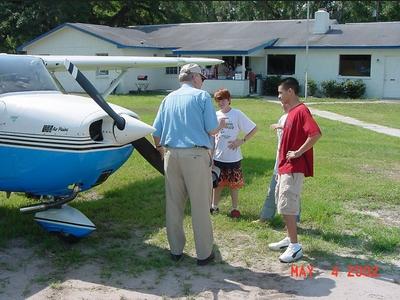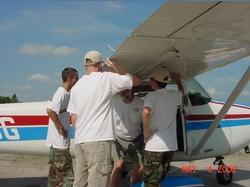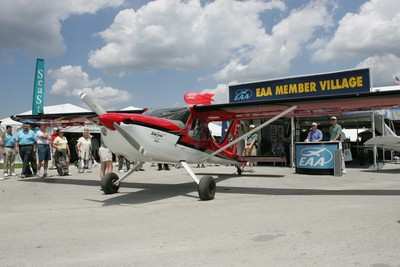Does EAA's Recent Young Eagles' Data Add Up?
By ANN Guest Columnist Rich Davidson
 The time has come for aviation to
embrace a cold soul searching willingness to challenge everything
we've been told or believe about our sport. Instead though,
aviation's leaders continue to shore up reputations, seek out
quantity over quality, and treat us like mushrooms.
The (most recent) example comes from
EAA.
The time has come for aviation to
embrace a cold soul searching willingness to challenge everything
we've been told or believe about our sport. Instead though,
aviation's leaders continue to shore up reputations, seek out
quantity over quality, and treat us like mushrooms.
The (most recent) example comes from
EAA.
You
may have read recently, my take on EAA's Young Eagles
Program. If so, you likely had one of three responses;
he's wrong, he's right, or I feel he's right but I am unwilling to
let go of my desire to believe Young Eagles produces new pilots.
Well, if you are the later, please remember that I did not say
Young Eagles never produced a pilot. And if you said "he's wrong",
today you are likely laughing with glee due to EAA's release of
their Young Eagles pilot certification matching statistics.
Unfortunately, EAA is wrong once again.
Today, many people learned that EAA has been matching up names
of Young Eagles, the only record they ever kept, to the FAA pilot
database in an attempt to extrapolate information; information that
would prove Young Eagles is a great success. And boy did they pull,
tug, and rip information from the data they found. Unfortunately,
there is a problem; they are making baseless assumptions. This is
concerning. EAA flat out refuses to look at reality and instead
they are seeing what they want to see; their pet program is a huge
success.
Many people, when they hear me question these EAA releases, go
immediately to the "you hate EAA" fallback position that allows
them to discount what I am suggesting without putting any thought
into it. That's fine with me. It's their choice what to believe.
But please do not say I hate EAA, simply because I am asking for
logic. To the contrary, I love EAA and I believe it needs help. And
when things are not going well, I think some tough love and logic
should win out over feel good "trust me" promises.
EAA's latest feel good production is the result of their pilot
certificate database search for names recorded in the Young Eagle's
logbook. In what is perhaps one of the most blatant twistings of
irrelevant data I have ever seen, EAA has left me with two
feelings, either they are blatantly telling us something they do
not really believe, or they have people running the show who do not
understand basic cause and effect relationships. Neither of which
is a good indicator for the longevity of an organization.

With this recent release of "data," EAA is making the following
claims, assumptions, or inferences:
- 7.3 percent of all pilots below age 35 are former Young Eagles
(the oldest Young Eagles from 1992 are now reaching age 35).
- Young Eagles are 5.4 times more likely to earn a pilot
certificate than those who have not flown as a Young Eagle.
- Nine percent of those pilots are female, a 50 percent
difference when compared to females being just 6 percent of the
current U.S. pilot population.
- Two out of every 100 young people who take their first Young
Eagles flight at age 17 earn pilot certificates. The older a Young
Eagle is at the time of a first flight, the more likely that young
person is to become a pilot. Young Eagles ages 13 and up are
especially more likely to pursue a pilot certificate.
- The more flights that a Young Eagle takes, the more likely that
young person will become a pilot.
The interesting thing is that Young Eagles has been very
successful at one thing, giving free rides to kids. Nobody can deny
that and nobody would say that these rides are patently useless. To
the contrary, giving kids rides is a great way to share aviation. I
just do not believe these rides just are an economical or effective
way to generate NEW pilots from a population of kids who otherwise
have no PRIOR interest in flying. This is the hidden flaw in all of
EAA's assumptions and inferences.
To make my position easier to understand, think of the kid who
builds airplane models. I think nearly everyone would agree with
the statement "Kids who build airplane models have an inherent or
pre-existing interest in aviation". But if Monogram or Revell model
companies were using the same statistical analyst EAA is using,
whoever that mystery person is, they would be telling us the same
thing; kids who build their models are 5.4 times more likely to
earn a pilot's certificate than kids who have never built an
airplane model. Do you see how laughable and yet relative this
information is? And do you see how this information relates to
pilot's certificates?

If my example was successful, you now see what a good
statistical analyst would see in this information; the truly useful
information that is overlooked. If you had a way to track the kids
that build aircraft models, you would already have a wealth of
information as to who would be seeking out flight training in later
years. Likewise, if you were honest with the Young Eagles
information, you would understand that Young Eagles doesn't create
pilots. More correctly stated, Young Eagles is an indicator of kids
who have a pre-existing interest in flight.
EAA is not alone in their mistake though, and it's time for
aviation to get serious about the future of flight.

Here is a brief explanation of EAA's inferences above. I say
they are inferences because they do, more than anything, infer that
Young Eagles is responsible for all the data. Unfortunately, their
statistics merely mirror what we already knew about aviators.
- EAA - 7.3 percent of all pilots below age 35 are former
Young Eagles (the oldest Young Eagles from 1992 are now reaching
age 35).
Explanation - This is written to infer 7.3
percent are because of Young Eagles yet it doesn't say that does
it. Like my example above, I'm sure you could generate a
statistical number that showed a certain percentage of pilots in
that age group built aircraft models. This does not convey model
building created an interest that wasn't already there. Young
Eagles is also very good at one thing, giving free rides to kids.
Therefore, if a kid had a true interest in aviation during the
lifetime of Young Eagles, it is very likely they went for a free
ride. It does not mean 7.3 percent of all pilots in the stated age
category would not have been pilots were it not for a Young Eagles
ride.
- EAA - Young Eagles are 5.4 times more likely to earn a
pilot certificate than those who have not flown as a Young
Eagle.
Explanation - Again, this is written to infer
Young Eagles increased the likelihood of people earning their
pilot's certificate. Unfortunately, it does not do that. It merely
indicates the obvious correlation that kids who were already
interested in flying were 5.4 times more likely to go for Young
Eagles rides.
- EAA - Nine percent of those pilots are female, a 50
percent difference when compared to females being just 6 percent of
the current U.S. pilot population.
Explanation - This increased has happened in
every aspect of our culture over the same period. Are we to believe
Young Eagles rides are responsible for the increase in female
CEO's, the increase in female Harley Davidson riders, females on
previously all male sports teams, and female politicians? No, this
merely parallels trends in all of the USA.
- EAA - Two out of every 100 young people who take their
first Young Eagles flight at age 17 earn pilot certificates. The
older a Young Eagle is at the time of a first flight, the more
likely that young person is to become a pilot. Young Eagles ages 13
and up are especially more likely to pursue a pilot
certificate.
Explanation - Again, didn't we already know
this? Wait, what is it we know? This infers Young Eagles rides
increase the chance of a kid getting a pilot's certificate if the
kid is older. Unfortunately, the older a kid is, the more firmed up
their desires are and the more life experience they have.
Therefore, just like the older kid that is still building models at
age 17, the older kid going for Young Eagles rides is naturally
more likely to have a real passion for flight. The building of
models, or Young Eagles, did not create that passion, it is an
expression of it.
- EAA - They do not give a total number of pilots
produced.
Explanation - You figure it out.
- EAA - The more flights that a Young Eagle takes, the
more likely that young person will become a pilot.
Explanation - In letter count, this is the
smallest inference advanced by EAA. Yet what they infer is bold.
Here it is suggested that the more you fly with Young Eagles the
more likely you are to become a pilot. Instead, I believe a good
analyst would find those kids, who are most passionate about
flight, do everything they can to get additional rides. This is the
logical inference but it is nowhere to be found. And what about
EAA's one flight rule?
In conclusion, what I wish to point out that if EAA, and
aviation as a whole, were willing to see the true morsels of
information in these programs they might be useful to the future of
aviation. Just look at Sporty's.
Hal Shevers, of Sporty's fame, has been in business a long time
and he is no dummy. He also is a big supporter of Young Eagles. By
getting Sporty's in front of Young Eagles at an early age, I'm sure
he knows what few are willing to admit or maybe they don't realize;
the kids coming for Young Eagles are already tomorrow's pilots.
Young Eagles merely finds them for him. This allows Sporty's to
offer programs that help both Hal's bottom line and potential
students achieve their goal of flight.

I hope you do not misunderstand. Hal has been a long time
supporter of aviation. I am just pointing out that if you want to
keep aviation alive, aviation businesses must be kept alive, and to
keep them alive, we can no longer afford feel good baseless
information over honest, hard cutting data. Of course, that kind of
information doesn't generate the level of donations EAA expects.
But maybe it would; if only they would try.
With all the above considered, there is one question that must
be asked:
If EAA has touched 1.6 million kids who had an interest in
flight, why then have they produced so few pilots from these ranks;
a number conspicuously absent from EAA's statistics. It really is a
good question.
 ANN's Daily Aero-Linx (04.15.24)
ANN's Daily Aero-Linx (04.15.24) Classic Aero-TV: 'No Other Options' -- The Israeli Air Force's Danny Shapira
Classic Aero-TV: 'No Other Options' -- The Israeli Air Force's Danny Shapira Aero-News: Quote of the Day (04.15.24)
Aero-News: Quote of the Day (04.15.24) Airborne 04.16.24: RV Update, Affordable Flying Expo, Diamond Lil
Airborne 04.16.24: RV Update, Affordable Flying Expo, Diamond Lil ANN's Daily Aero-Term (04.16.24): Chart Supplement US
ANN's Daily Aero-Term (04.16.24): Chart Supplement US







